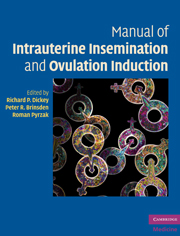Book contents
- Frontmatter
- Contents
- List of contributors
- Preface
- 1 An overview of intrauterine insemination and ovulation induction
- 2 Male causes of infertility: evaluation and treatment
- 3 Female causes of infertility: evaluation and treatment
- 4 Clinic and laboratory design, personnel and equipment
- 5 Semen analysis: semen requirements for intrauterine insemination
- 6 Semen preparation for intrauterine insemination
- 7 Ovulation induction for intrauterine insemination I: oral drugs clomiphene, tamoxifen, letrozole
- 8 Ovulation induction for intrauterine insemination II: gonadotropins and oral drug–gonadotropin combinations
- 9 Ultrasonography in the management of ovulation induction and intrauterine insemination
- 10 Insemination technique and insemination complications
- 11 Cryopreservation
- 12 Donor sperm
- 13 The role of the nurse in intrauterine insemination and ovulation induction
- 14 Complications of ovulation induction I: high-order multiple births, miscarriage, ectopic pregnancy, congenital anomalies, ovarian cancer
- 15 Complications of ovulation induction II: ovarian hyperstimulation syndrome, ovarian torsion
- 16 The psychological issues of intrauterine insemination
- 17 Ethical, legal and religious considerations of artificial insemination
- Index
3 - Female causes of infertility: evaluation and treatment
Published online by Cambridge University Press: 01 February 2010
- Frontmatter
- Contents
- List of contributors
- Preface
- 1 An overview of intrauterine insemination and ovulation induction
- 2 Male causes of infertility: evaluation and treatment
- 3 Female causes of infertility: evaluation and treatment
- 4 Clinic and laboratory design, personnel and equipment
- 5 Semen analysis: semen requirements for intrauterine insemination
- 6 Semen preparation for intrauterine insemination
- 7 Ovulation induction for intrauterine insemination I: oral drugs clomiphene, tamoxifen, letrozole
- 8 Ovulation induction for intrauterine insemination II: gonadotropins and oral drug–gonadotropin combinations
- 9 Ultrasonography in the management of ovulation induction and intrauterine insemination
- 10 Insemination technique and insemination complications
- 11 Cryopreservation
- 12 Donor sperm
- 13 The role of the nurse in intrauterine insemination and ovulation induction
- 14 Complications of ovulation induction I: high-order multiple births, miscarriage, ectopic pregnancy, congenital anomalies, ovarian cancer
- 15 Complications of ovulation induction II: ovarian hyperstimulation syndrome, ovarian torsion
- 16 The psychological issues of intrauterine insemination
- 17 Ethical, legal and religious considerations of artificial insemination
- Index
Summary
Conception requires ovulation of a mature oocyte, normal fallopian tubes, the presence of progressively motile sperm in the female reproductive tract, and an endometrium favorable for implantation.
RPD, PRB, 2009Introduction
The incidence of female infertility is age- and parity-related. In a national government survey conducted in 2002, 7.4% of all married women in the United States, aged 15–44, reported difficulty becoming pregnant during the previous year. The incidence of infertility ranged from a low of 4% in previously pregnant women aged under 30, to 27% in never-pregnant women aged 40–44. In a previous survey of the same population, 35% of women who sought medical help were treated with ovulation induction (OI), 13% with husband or donor intrauterine insemination (IUI) and 1.7% with in-vitro fertilization (IVF) or other advanced assisted reproductive technology (ART). Similar infertility rates are reported elsewhere in the Western world, with the availability of infertility treatment facilities and the use of IVF varying both between and within countries. In 2003, IVF was responsible for 6.5% of live births in Denmark and 3% of all live births in Europe, compared to 1.2% of live births in the United States. Patients in the United States with private health insurance were four times more likely to receive OI and three times more likely to have IUI than patients without insurance, but no more likely to have IVF than patients without insurance.
The causes of infertility in 14,141 couples, from reports compiled in 1995, were ovulatory disorder 27%, abnormal semen 25%, tubal occlusion 22%, endometriosis 5% and unexplained 17%.
- Type
- Chapter
- Information
- Publisher: Cambridge University PressPrint publication year: 2009



